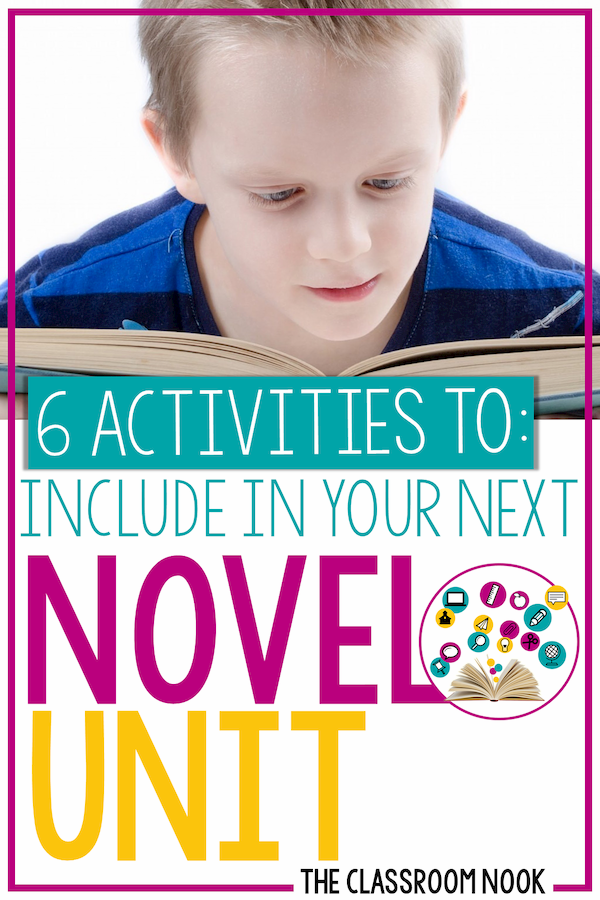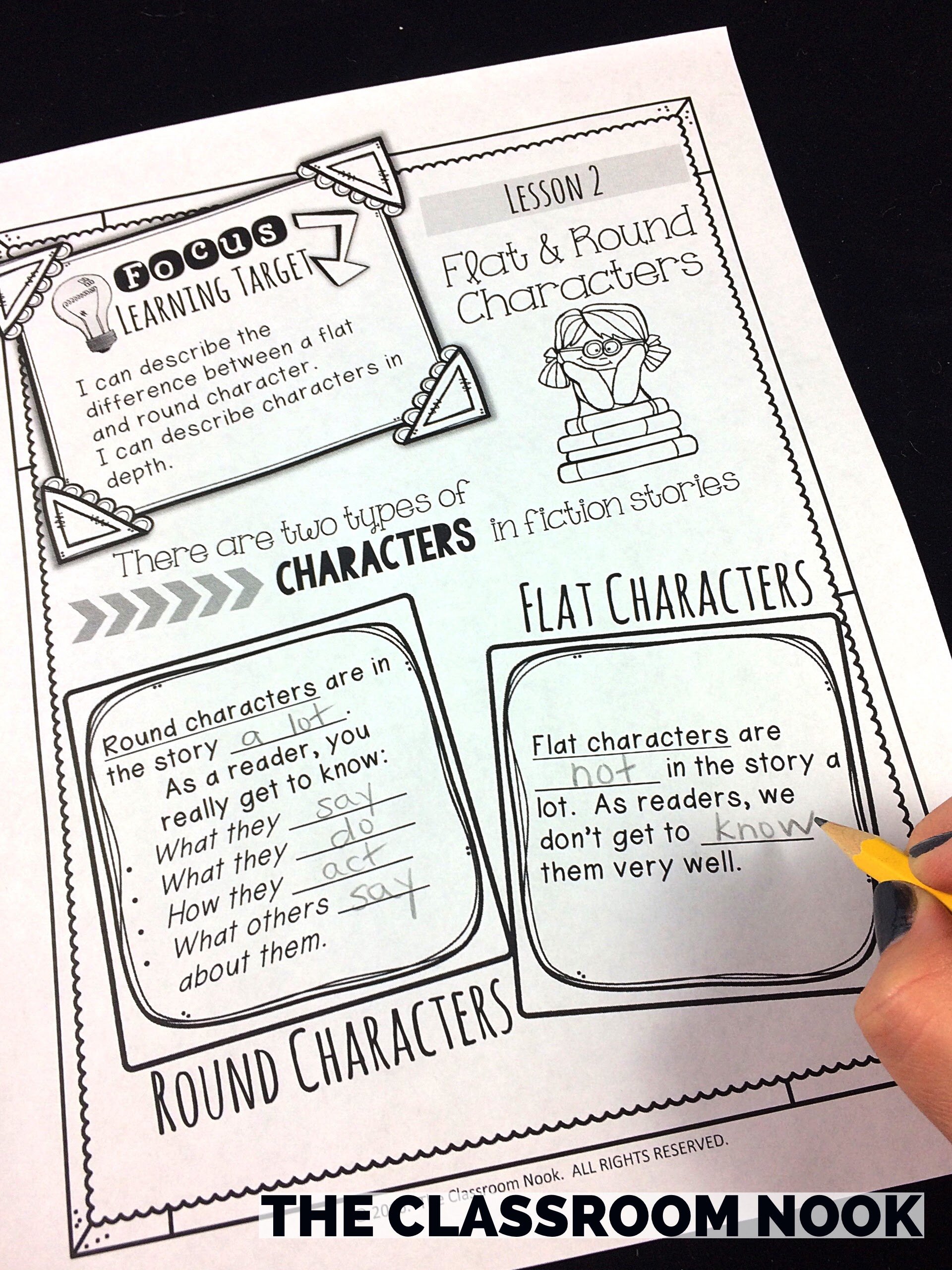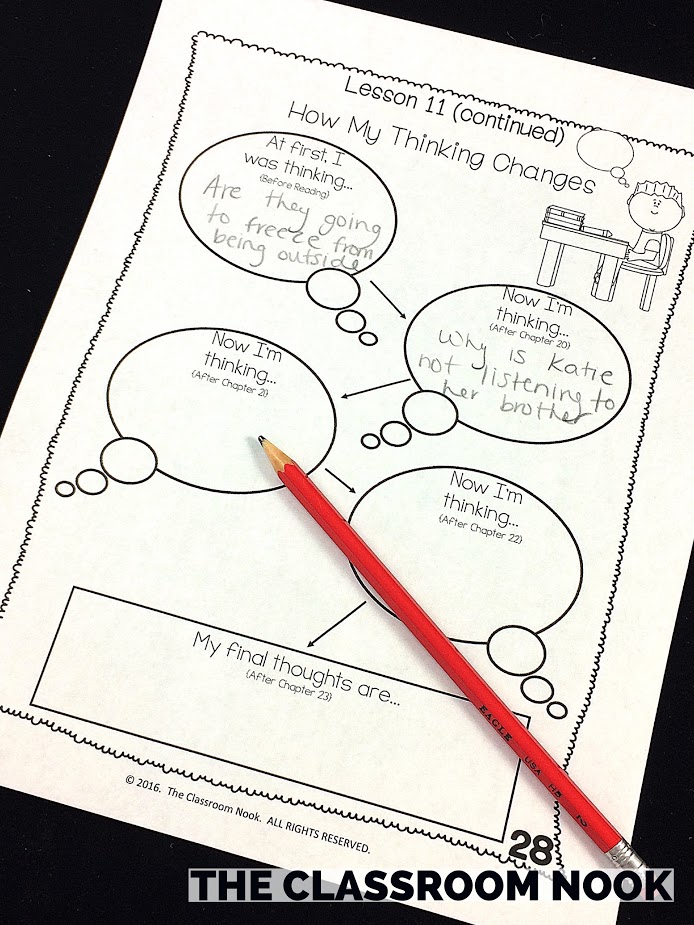6 Activities to Include in Your Next Novel Unit

If you teach in the upper elementary grades, chances are you spend a good chunk of time during your literacy block reading novels with your students.
Whether your students are reading the novel as a whole-class, in guided reading groups, in literature circles, or even as individuals, there are some activities that work great with almost any novel. And, in this post, I'm going to share 6 activities that I have used over and over in the different novels that I have read with my own students.
IDENTIFY FLAT AND ROUND CHARACTERS
One thing that I often had my students do, almost from the beginning of the novel, was to begin identifying flat and round characters.
If you are unfamiliar with these terms, let me clarify: Flat characters are those characters that only appear in the story once or twice, and don't really impact the story's outcome. The reader doesn't really learn much about the flat characters.
Round characters, on the other hand, are the lead characters of the story. Their words and actions greatly impact the events and outcome of the story. The reader gets to know these characters in great detail through their words, thoughts, and actions.
In a novel unit using the book Shiloh, we designated a portion of our unit bulletin board for identifying and keeping track of round and flat characters. As characters came in and out of the book, we placed these characters' names under the correct heading. Students often found that while reading, characters moved from one category to another. A character that did not seem so significant at the beginning of the novel, tagged a "flat," actually turned into a pretty important character half-way through the story. We had to move that character from "flat" to "round." The discussion around flat and round characters is on-going through the novel.
MAKE A CHARACTER MAP AND COMPLETE A CHARACTER ANALYSIS
Speaking of characters, once students do identify those round characters, they can begin to really dive deep into getting to know them. We teach our students that getting to know a character really well means that we can describe things that the character wants, thinks, feels, does, and says.
My students would show their understanding of a character by completing a character map, like this one from the novel unit on Because of Winn-Dixie. The character map then sets the foundation for being able to analyze that character and discuss how the character develops and changes over the course of the novel. You might even have students complete a character map on the same character several times throughout the novel to show how the character is changing.
We can teach our students that to analyze a character, we focus on 4 things that can change in a character:
his/her physical appearance
his/her intelligence
his/her social abilities
his/her feelings
Help your students to keep track of a character's development by recording evidence found in the text, categorized into these 4 main character changes.
In the novel Dear Mr. Henshaw, the story is written in a diary/letter format, documenting the thoughts and feelings of the main character, Leigh Botts. While my students read the diary entries, I had them record things that Leigh wrote about in his diary that showed development in any of these 4 areas. Students continued to add to these pages throughout the novel.
TURN AN EXCERPT FROM THE STORY INTO A READER'S THEATER SCRIPT
I've said it before- I love using reader's theater as a tool in the classroom! It works especially well in a novel unit because a lot of the work is done for you. Simply take the dialogue and narration from the story and retype it into a script format.
Choose a critical event from the story and have students act it out in small groups. Reader's theater provides meaningful fluency practice and can spark some great discussion around these critical events. Teach students to use appropriate tone of voice to convey the feelings behind the characters and events in the script.
PAIR FICTION AND NONFICTION WHERE POSSIBLE:
Finding a nonfiction text that pairs will with your novel works especially well with realistic and historical fiction novels. For example, when my students were reading about how Judd, a main character in the book Shiloh, was mistreating his dog, I had them read a nonfiction article about animal rights. The connection was perfect, and through the article I was able to teach important nonfiction reading skills like headings and bold words.
HAVE STUDENTS CATEGORIZE BOOK QUOTES:
Inferring is an important skill that we teach our students. One authentic way to do this is by having students infer the feelings represented in different quotes by the characters in the novel.
Let me show you what I mean: During my Dear Mr. Henshaw novel unit, I gave students a set of quote cards. The quotes were all said by the main character, Leigh Botts as he experienced the ups and downs of boyhood and middle school life. I asked for students to try to infer the emotion behind each quote. In a center activity, students read each quote card, and then categorized the quotes into "emotion" categories. In the center, students had to use evidence from the text to back up their categorizing decisions. Try having your students do the same by grouping quotes from your novel into categories. I chose emotions, but you could choose other category groups that make sense for your novel.
HAVE STUDENTS SHOW HOW THEIR THINKING CHANGES:
Finally, I like to encourage students to show their thinking as they read. We teach our students how characters can develop and change over the course of the novel, but we also need to teach how the reader's thoughts, feelings, and opinions can change as well. I use a simple graphic organizer (like the one shown here from my George Washington's Socks unit) where students can record their thinking before reading (based on previous events), during reading (as the events are happening), and after reading.
I prompt students to pause their reading periodically to write down their thoughts about the events as they happen. This type of activity works best when students are about to read a critical event in the story; an event that changes the outcome of the story, or comes as a complete shock to the reader. Since all readers think a little differently, these graphic organizers can be a great spring board for deep discussion about the book.
All of these activities help students to think critically and deeply about the characters and events in a novel. I like how these activities can be repeated time and time again in novels all year long. The more practice students get with these activities, the richer the conversations will be.








